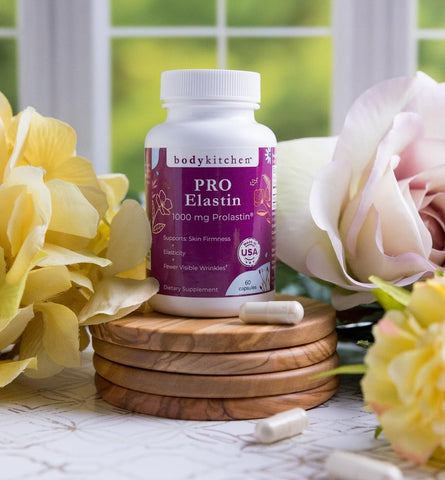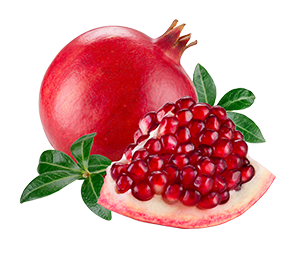Your How-to Guide for Increasing GLP-1 Levels Naturally
Did you hear about the newest celebrity who went on a popular “weight loss drug” and emerged looking slimmer and thinner?
You may not know what GLP-1 means, but you cannot ignore the stories about semaglutide and the array of “anti-hunger” medications. Not only are they the hot topic in Hollywood, but also among regular people who feel trapped in their bodies as a result of endless, lifelong and recurring weight-loss struggles.
Born in the 2000s, GLP-1 medications were – and continue to be – an intervention for managing blood sugar levels. The melting of body fat is a happy side effect, which is why they have become as synonymous with weight-loss as collagen is with skin radiance.
And, like collagen, your body naturally produces GLP-1 to help you maintain a fit metabolism and healthy weight.
Your body’s hunger switch
GLP-1 regulates appetite by dampening hunger and making you feel full longer. It also regulates metabolism and blood sugar by supporting insulin production and uptake, which, in turn, support cardiovascular health.
So, there’s no question that ramping up your natural production of GLP-1 supports a healthy, happy body and improves your ability to control your weight.
GLP-1 and your gut
Shorthand for glucagon-like peptide-1, GLP-1 is a multi-faceted peptide, hormone and neurotransmitter produced in the L-cells of the gastrointestinal walls where satiety signals are transmitted.
As a metabolic hormone, GLP-1 works to keep blood glucose levels stable to ensure there’s a reliable and consistent source of energy.
As a peptide, it’s comprised of amino acid chains that bind to protein receptors in the pancreas and brain.
And finally, as a neurotransmitter, GLP-1 crosses the gut-brain barrier to transmit signals between nerve cells.
But how exactly did hard-working GLP-1 gain its reputation as a weight-loss wonder?
Weight loss starts in the gut
Weight-loss drugs mimic the effects of GLP-1. *
Eating sets in motion a sequence of activities that start in the GI tract and have immediate and long-term effects on your heart, blood pressure, circulation, metabolism and blood sugar… whether the effects are beneficial or harmful depends on the composition of what you regularly eat.
As food digests, GLP-1 stimulates the pancreas to produce more insulin after meals, which allows cells to admit glucose to be stored and burned for energy. This helps keep blood sugar levels stable.
GLP-1 also has an appetite-suppressing effect by helping food stay in your stomach longer before moving into the intestine, allowing satiety signals to reach your brain and instruct you to stop eating.
High levels of GLP-1 allow you the opportunity to eat until you feel satisfied, then stop when you feel full.
GLP-1 for heart health
More than a weight-loss aid, GLP-1 is vital to the complementary set of health systems that make up your cardiometabolic well-being, which influence your risk factors for serious health conditions.
Naturally occurring GLP-1 promotes: ***
- Cholesterol and triglycerides breakdown
- Blood flow and blood pressure balance
- Arterial and blood vessel function
- Anti-inflammatory response
Natural energy booster
Cells that are depleted of energy don’t have fuel to give. But when GLP-1 production is efficient, you feel good and energetic.
Your muscles and brain need GLP-1 to be responsive to daily demands, giving you stamina and making it less likely you’ll forage for sweets, carbs and caffeine for an artificial (and temporary) energy boost.
GLP-1-Boosting Smoothie
Feed your gut right with our delicious Cherry Smoothie. Marked by a beautiful deep-red pigment, cherries are loaded with polyphenols – prebiotic superfoods that nourish the colonies of healthy gut microbiota and help the microbiome thrive. Get the recipe!
What depletes GLP-1 levels?
The lack of diversity in gut microbiota is known to reduce levels of GLP-1, a major risk factor in developing metabolic conditions, including diabetes and obesity. **
When levels of GLP-1 run low, blood sugar levels run high, which over time can damage the processes involved in creating, storing and using energy efficiently.
How to make more GLP-1
Whether you want to lose weight, give your cardiovascular health a hand or improve your GI health and digestion, ramping up your levels of GLP-1 naturally is an excellent step toward feeling healthy and full of life every day.
Because GLP-1 production starts in the gut, a nourished microbiome starts with biodiversity. And there’s no better way than to increase the diversity of good bacteria than with a diversity of prebiotics and probiotics.
Prebiotics activate your GLP-1 factory
Prebiotics are an elite type of plant fiber that beneficial bacteria – or probiotics – feed upon.
Unlike other healthy fibers that are digested in the small intestine, prebiotics journey to the gut microbiome where they are fermented and transformed into energy sources for live beneficial cultures.
There are different types of prebiotics and they all play their part in keeping GLP-1 production humming by promoting the growth of good gut bacteria and inhibiting the growth of harmful strains.
Naturally occurring prebiotics and where to find them
- Beta-glucans – barley, mushrooms (pearl and shitake), oats, yeast
- Fructooligosaccharides (FOS) – asparagus, artichokes, garlic, onions
- Inulin – artichokes, asparagus, bananas, garlic, oats, onions, soybeans, wheat
- Galactooligosacharides (GOS) – beans, cheese, lentils, peas, raspberries, yogurt
- Pectin – apples (peels), apricots, citrus (peels), plums
- Polyphenols – berries, cherries, dark chocolate, grapes, tea (black and green)
- Resistant starches – green bananas, cooked and cooled pasta, rice and potatoes
More probiotics = higher GLP-1 levels
There are roughly 100 trillion microbes, such as bacteria, fungi, parasites and viruses, coexisting in your gut. The key to this coexistence is having a healthy balance between healthy and harmful bacteria.
Healthy strains of bacteria work 24/7 to keep the number of harmful strains from overrunning the gut and disrupting your microbiome’s ability to absorb nutrients, aid digestion, support immune function and promote cognition.
As vital as probiotics are to your total body health, it’s fitting that one research study referred to beneficial microbes as “the pharmacy in the gut”. *
Powered by prebiotics, probiotics stimulate production of GLP-1 in multiple direct and indirect ways. *
Well-known probiotic strains
- Bacteroides – comprises about 30% of all good gut microbes in your body
- Bifidobacterium – found in the colon; digest fiber and fight harmful bacteria
- Lactobacillus – found in the small intestine; aid digestion and produce lactic acid
- Streptococcus thermophilus – commonly used in yogurt; aids lactose digestion
Can supplements boost GLP-1?
Supplements are an effective way to fill nutritional gaps that are left when you cannot consume a wide variety of plant foods, and to isolate and increase the concentration of active ingredients that you cannot consume through dietary intake alone.
By supplementing prebiotics, probiotics or both, you help create a strong and diverse GI ecosystem that boosts the natural production of GLP-1. You support your digestive health in the short term, such as by helping to soothe digestive issues, from bloating to constipation, and strengthen the gut barrier for a healthier, nourished body.
Plus, over time, bolstering your GI health also supports a healthy weight and your metabolic, heart and immune health.
When picking a good probiotic supplement, look for one formulated with clinically studied live strains that are specially designed to survive the passage through the stomach and to the gut where they can recolonize good bacteria.
This is more important than the amount of colony forming units (CFUs) supplied, because probiotics are beneficial only if they can reach the gut microbiome.
For a seasonful of savings, take advantage of our Buy 1 Get 1 50% offer. Stock up on Gut Balance or any Body Kitchen product for the best deal of the summer!














